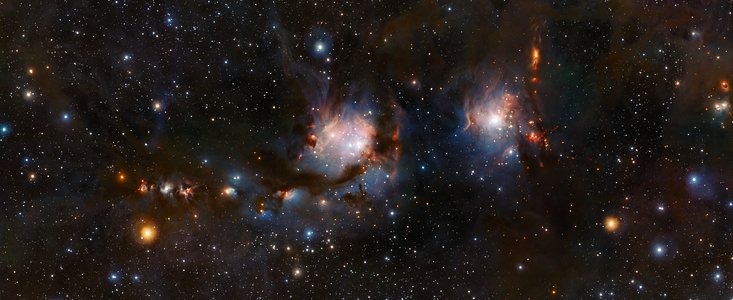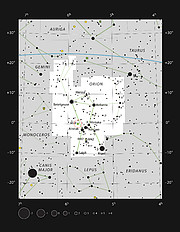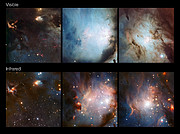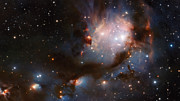Persbericht
ESO’s ‘stofzuiger’ onthult verborgen sterren
5 oktober 2016
Op deze nieuwe opname van de nevel Messier 78 geven jonge sterren hun omgeving een blauwachtige gloed, terwijl rode sterren-in-wording zich aan hun cocons van kosmisch stof proberen te ontworstelen. Voor onze ogen zouden de meeste sterren verscholen gaan achter het stof, maar ESO’s Visible and Infrared Survey Telescope for Astronomy (VISTA) ziet nabij-infrarood licht, dat dwars door het stof heen gaat. De telescoop fungeert als een reusachtige stofzuiger waarmee astronomen diep in het hart van de nevel kunnen doordringen.
Messier 78, of M78, is een goed onderzocht voorbeeld van een reflectienevel. Hij bevindt zich op een afstand van ongeveer 1600 lichtjaar in het sterrenbeeld Orion, eventjes linksboven de drie sterren die de ‘gordel’ van deze bekende figuur aan de hemel vormen. Op deze foto vertoont M78 zich als de blauwe gloed in het midden; de reflectienevel rechts ervan staat bekend als NGC 2071. De ontdekking van M78 wordt toegeschreven aan de Franse astronoom Pierre Méchain. Maar zijn aanduiding verwijst naar een andere Franse astronoom, Charles Messier, die het object in december 1780 toevoegde aan zijn catalogus van nevelachtige hemelobjecten.
Wanneer M78 wordt waargenomen door instrumenten die zichtbaar licht registreren, zoals de Wide Field Imager van de ESO-sterrenwacht op La Silla, vertoont deze zich als een gloeiende, azuurblauwe nevel die omringd is door donkere slierten (zie eso1105). Kosmisch stof weerkaatst en verstrooit het licht dat wordt uitgestraald door de jonge, blauwachtige sterren in het hart van M78. Vandaar dat dit object een reflectienevel wordt genoemd.
De donkere slierten zijn dikke wolken van stof die het zichtbare licht van alles wat zich daarachter bevindt tegenhoudt. Deze dichte, koude gebieden zijn uitstekende locaties voor de vorming van nieuwe sterren. Wanneer M78 en zijn buren worden waargenomen in submillimeterlicht, dat het midden houdt tussen radiogolven en infrarood licht – bijvoorbeeld met de Atacama Pathfinder Experiment (APEX) telescoop – dan vertonen zij de gloed van stofconcentraties die nauwelijks warmer zijn dan hun extreem koude omgeving (zie eso1219). Uiteindelijk zullen deze concentraties onder invloed van de zwaartekracht samentrekken en opwarmen, waardoor nieuwe sterren ontstaan.
Tussen zichtbaar en submillimeterlicht ligt het nabij-infrarode deel van het spectrum, waar de Visible and Infrared Survey Telescope for Astronomy (VISTA) astronomen van cruciale informatie voorziet. VISTA maakt de heldere stellaire bronnen zichtbaar die zich achter de stofrijke reflecties en de meest doorschijnende delen van de donkere slierten bevinden. In het midden van deze foto staan twee helder stralende superreuzensterren, die HD 38563A en HD 38563B worden genoemd. Rechts daarvan zien we de superreus HD 290861, die de naburige nevel NGC 2071 doet oplichten.
Naast grote, blauwe, hete sterren ziet VISTA ook veel sterren-in-wording die ontstaan uit het kosmische stof waarmee dit gebied bezaaid is. Ze zijn gemakkelijk te herkennen aan hun rode en gele tinten. Deze kleurrijke onvolgroeide sterren zijn te vinden in de stofbanden rond NGC 2071 en langs het stofspoor dat zich op deze foto naar links uitstrekt. Sommige van hen zijn T Tauri-sterren. Ondanks dat ze vrij helder zijn, zijn ze nog niet heet genoeg om kernfusiereacties in hun kernen op te starten. Pas over tientallen miljoenen jaren zullen zij volwassen zijn en hun plaats innemen tussen hun stellaire zusjes die M78 laten gloeien.
Meer informatie
ESO is de belangrijkste intergouvernementele astronomische organisatie in Europa en de meest productieve sterrenwacht ter wereld. Zij wordt ondersteund door zestien lidstaten: België, Brazilië, Denemarken, Duitsland, Finland, Frankrijk, Italië, Nederland, Oostenrijk, Polen, Portugal, Spanje, Tsjechië, het Verenigd Koninkrijk, Zweden en Zwitserland, en door gastland Chili. ESO voert een ambitieus programma uit, gericht op het ontwerpen, bouwen en beheren van grote sterrenwachten die astronomen in staat stellen om belangrijke wetenschappelijke ontdekkingen te doen. Ook speelt ESO een leidende rol bij het bevorderen en organiseren van samenwerking op astronomisch gebied. ESO beheert drie waarnemingslocaties van wereldklasse in Chili: La Silla, Paranal en Chajnantor. Op Paranal staan ESO’s Very Large Telescope (VLT), de meest geavanceerde optische sterrenwacht ter wereld, en twee surveytelescopen: VISTA werkt in het infrarood en is de grootste surveytelescoop ter wereld en de VLT Survey Telescope is de grootste telescoop die specifiek is ontworpen om de hemel in zichtbaar licht in kaart te brengen. ESO is ook de Europese partner van de revolutionaire telescoop ALMA, het grootste astronomische project van dit moment. En op Cerro Armazones, dicht bij Paranal, bouwt ESO de 39-meter Europese Extremely Large optical/near-infrared Telescope (E-ELT), die ‘het grootste oog op de hemel’ ter wereld zal worden.
Links
Contact
Richard Hook
ESO Public Information Officer
Garching bei München, Germany
Tel: +49 89 3200 6655
Mobiel: +49 151 1537 3591
E-mail: rhook@eso.org
Marieke Baan (Perscontact Nederland)
ESO Science Outreach Network
en NOVA Informatie Centrum
Tel: +31(0)20-5257480
E-mail: eson-netherlands@eso.org
Over dit bericht
| Persberichten nr.: | eso1635nl |
| Naam: | M 78, Messier 78 |
| Type: | Milky Way : Nebula : Type : Star Formation Milky Way : Nebula : Appearance : Emission : H II Region |
| Facility: | Visible and Infrared Survey Telescope for Astronomy |
| Instruments: | VIRCAM |






